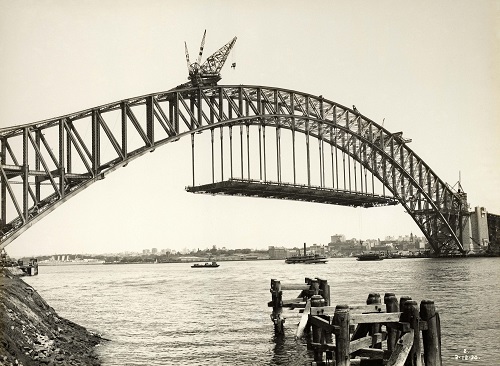Project Iron Boomerang as envisaged by project founder Shane Condon would see 44 million tonnes of steel slabs exported per year, 22 million tonnes from Port Hedland in Western Australia and 22 million tonnes from Abbot Point in Queensland. The world will need more steel production as developing nations expand their economies, but Australia could well use at least an additional ten million tonnes of steel to address an infrastructure deficit and build for the future. Current Australian steel consumption is around 9 million tonnes per year, of which more than a third is imported. The nation’s steel production per capita is now only one-third of the peak output which occurred in 1974. Given pressing infrastructure needs, a doubling or tripling of Australian steel consumption would not be unreasonable.

Road construction and tunnelling will require millions of tonnes of steel-reinforced concrete nationwide. The West Gate Tunnel Project alone, now under construction in Victoria, will use 92,200 tonnes of steel from Docklands to Laverton in the lining of the project’s twin tunnels, bridge segments, noise walls and retaining walls. This is just a few kilometres across Melbourne, so imagine what’s possible with a genuine nationwide program for infrastructure-building like that of China, which spent 8.3 per cent of GDP on infrastructure between 2010 and 2015. In the early 1960s Australia spent 6 per cent of GDP on infrastructure and now it sits close to 4 per cent, with government outlaying about half of the funding.
Sydney Harbour Bridge contains 52,800 tonnes of steel. Several bridges of a similar size should be built in Australia’s capital cities to ease traffic congestion and plan for future economic expansion. In August 2018 Senior Lecturer in Civil Engineering at Monash University, Dr Colin Caprani warned in Government News that in 10 to 15 years, Australia’s bridges will be in the same condition as those of the USA, where 30 per cent of 625,000 bridges are listed as functionally obsolete or structurally deficient. The Australian Government’s Bridges Renewal Program to fund the upgrade and replacement of bridges must be dramatically expanded. Round Five of the program announced on 29 September 2020 cited 205 projects across Australia, mostly for small bridges. Many thousands of such bridges need to be built or replaced, and hundreds of large bridges should be built. Overall, bridges across Australia will require millions of tonnes of steel.
Dam infrastructure will require significant quantities of steel in reinforced concrete. The Three Gorges Dam contains 463,000 tonnes of steel. Although Australia may not build a dam quite as large, many large dams are waiting to be built, collectively requiring several million tonnes of steel. The Snowy Mountains Scheme, which consists of 16 major dams, transformed much of the Murray-Darling Basin into productive irrigated land. Several other schemes of this scale are needed to transform barren lands into flourishing agricultural communities. The Clarence River Scheme proposed by Professor Lance Endersbee for northern New South Wales would require several large dams to store water for diversion into the Murray-Darling Basin. Likewise, the proposed Bradfield and Reid schemes in Queensland will require extensive dam works.
Steel pipelines for water, gas and oil will collectively require several million tonnes of steel. The nation has more than 39,000 kilometres of natural gas pipelines alone and as the economy expands with new cities, many more thousands of kilometres of pipelines will be needed to transport gas under high pressure from where it’s produced to households and businesses. The above water projects and others will require thousands of kilometres of steel pipelines. At 1.5 tonnes per metre, three steel water pipes from Tasmania to the mainland will require over 1 million tonnes of steel. This will ensure Victorian and South Australian water security in times of drought.
The Melbourne to Brisbane Inland Rail project will require up to 262,000 tonnes of steel, but a high-speed rail network across Australia will require several-fold more steel. For comparison, England’s planned high-speed railway (HS2) linking London, Birmingham, Manchester and Leeds will require around 2 million tonnes of steel. To build Prof. Endersbee’s Asian Express and Ring rail, along with the many other railways the nation needs, will require several million tonnes of steel.
Then there’s the steel required in mechanical equipment, and manufactured products etc., which outside of buildings and infrastructure, could amount to around half of the nation’s steel consumption. Gearing up manufacturing will be important for national security and self-sufficiency, and steel will be crucial in machine tools.
To get a sense of the scale of steel production, it’s noteworthy that China produced 996.3 million tonnes of crude steel in 2019. This massive steel production has been vital in lifting close to a billion Chinese people out of poverty. Clearly, to industrialise Africa with its 1.35 billion people, would be a similar task to what China has done in the last generation. And there are many nations outside of Africa requiring similar development. So even an additional 2 billion tonnes of steel could be utilised were there the political will to integrate this output with development. Australia must take leadership in steel production, build our nation, and help other nations build with Australian steel.
By Jeremy Beck, Australian Alert Service, 2 December 2020






